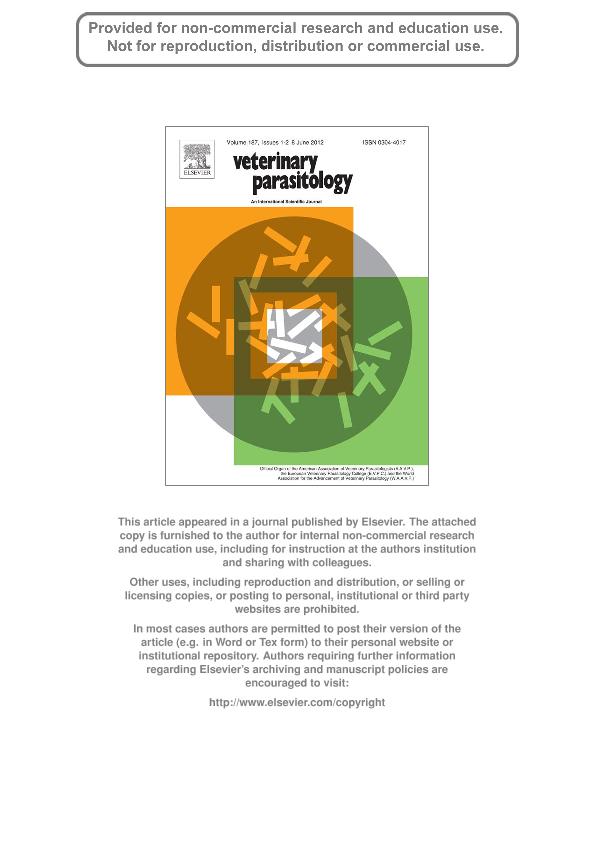Mostrar el registro sencillo del ítem
dc.contributor.author
Konrad, José Luis

dc.contributor.author
Moore, Dadin Prando

dc.contributor.author
Crudeli, Gustavo Angel

dc.contributor.author
Caspe, S. G.
dc.contributor.author
Cano, D. B.
dc.contributor.author
Leunda, M. R.
dc.contributor.author
Lischinsky, L.
dc.contributor.author
Regidor Cerrillo, J.
dc.contributor.author
Odeón, A. C.
dc.contributor.author
Ortega Mora, L. M.
dc.contributor.author
Echaide, I.
dc.contributor.author
Campero, C. M.
dc.date.available
2023-05-05T10:59:47Z
dc.date.issued
2012-01
dc.identifier.citation
Konrad, José Luis; Moore, Dadin Prando; Crudeli, Gustavo Angel; Caspe, S. G.; Cano, D. B.; et al.; Experimental inoculation of Neospora caninum in pregnant water buffalo; Elsevier Science; Veterinary Parasitology; 187; 1-2; 1-2012; 72-78
dc.identifier.issn
0304-4017
dc.identifier.uri
http://hdl.handle.net/11336/196380
dc.description.abstract
The aim of this study was to characterize the pathogenesis of Neospora caninum in experimentally inoculated pregnant water buffalo (Bubalus bubalis). Twelve Mediterranean female water buffaloes ranging in age from 4 to 14 years old and seronegative to N. caninum by indirect fluorescent antibody test (IFAT) were involved. Ten females were intravenously inoculated with 108 tachyzoites of NC-1 strain at 70 (n = 3) or 90 (n = 7) days of pregnancy (dp). Two control animals were inoculated with placebo at 70 and 90 dp, respectively. Serum samples were obtained weekly following inoculation to the end of the experiment. Three animals inoculated at 70 dp were slaughtered at 28 days post inoculation (dpi), three animals inoculated at 90 dp were slaughtered at 28 dpi and the remaining four animals inoculated at 90 dp were slaughtered at 42 dpi. Fetal fluids from cavities and tissue samples were recovered for IFAT and histopathology, immunohistochemistry and PCR, respectively. Genomic DNA from fetal tissues was used for parasite DNA detection and microsatellite genotyping in order to confirm the NC-1 specific-infection. Dams developed specific antibodies one week after the inoculation and serological titers did not decrease significantly to the end of the experiment. No abortions were recorded during the experimental time; however, one fetus from a dam inoculated at 70 dp was not viable at necropsy. Specific antibodies were detected in only two fetuses from dams inoculated at 90 dp that were slaughtered at 42 dpi. No macroscopic changes in the placentas and organs of viable fetuses were observed. Nonsuppurative placentitis was a common microscopic observation in Neospora-inoculated specimens. Microscopic fetal lesions included nonsuppurative peribronchiolar interstitial pneumonia, epicarditis and myocarditis, interstitial nephritis, myositis and periportal hepatitis. Positive IHC results were obtained in two fetuses from dams inoculated at 70 dp and slaughtered at 28 dpi. N. caninum DNA was detected in placentas and fetuses from all inoculated animals. The pattern of amplified microsatellites from placental and fetal tissues resembled the NC-1 strain. Water buffaloes, like cattle, are susceptible to experimental inoculation with N. caninum at early pregnancy.
dc.format
application/pdf
dc.language.iso
eng
dc.publisher
Elsevier Science

dc.rights
info:eu-repo/semantics/openAccess
dc.rights.uri
https://creativecommons.org/licenses/by-nc-sa/2.5/ar/
dc.subject
FETAL PATHOLOGY
dc.subject
NEOSPORA CANINUM
dc.subject
WATER BUFFALO
dc.subject.classification
Ciencias Veterinarias

dc.subject.classification
Ciencias Veterinarias

dc.subject.classification
CIENCIAS AGRÍCOLAS

dc.title
Experimental inoculation of Neospora caninum in pregnant water buffalo
dc.type
info:eu-repo/semantics/article
dc.type
info:ar-repo/semantics/artículo
dc.type
info:eu-repo/semantics/publishedVersion
dc.date.updated
2023-04-18T13:17:39Z
dc.journal.volume
187
dc.journal.number
1-2
dc.journal.pagination
72-78
dc.journal.pais
Países Bajos

dc.journal.ciudad
Amsterdam
dc.description.fil
Fil: Konrad, José Luis. Universidad Nacional del Nordeste; Argentina. Consejo Nacional de Investigaciones Científicas y Técnicas. Centro Científico Tecnológico Conicet - Nordeste; Argentina
dc.description.fil
Fil: Moore, Dadin Prando. Consejo Nacional de Investigaciones Científicas y Técnicas; Argentina
dc.description.fil
Fil: Crudeli, Gustavo Angel. Universidad Nacional del Nordeste; Argentina
dc.description.fil
Fil: Caspe, S. G.. Instituto Nacional de Tecnología Agropecuaria; Argentina
dc.description.fil
Fil: Cano, D. B.. Instituto Nacional de Tecnología Agropecuaria; Argentina
dc.description.fil
Fil: Leunda, M. R.. Instituto Nacional de Tecnología Agropecuaria; Argentina
dc.description.fil
Fil: Lischinsky, L.. Instituto Nacional de Tecnología Agropecuaria; Argentina
dc.description.fil
Fil: Regidor Cerrillo, J.. Universidad Complutense de Madrid; España
dc.description.fil
Fil: Odeón, A. C.. Instituto Nacional de Tecnología Agropecuaria; Argentina
dc.description.fil
Fil: Ortega Mora, L. M.. Universidad Complutense de Madrid; España
dc.description.fil
Fil: Echaide, I.. Instituto Nacional de Tecnología Agropecuaria; Argentina
dc.description.fil
Fil: Campero, C. M.. Instituto Nacional de Tecnología Agropecuaria; Argentina
dc.journal.title
Veterinary Parasitology

dc.relation.alternativeid
info:eu-repo/semantics/altIdentifier/url/https://www.sciencedirect.com/science/article/abs/pii/S0304401711008685?via%3Dihub
dc.relation.alternativeid
info:eu-repo/semantics/altIdentifier/doi/http://dx.doi.org/10.1016/j.vetpar.2011.12.030
Archivos asociados
